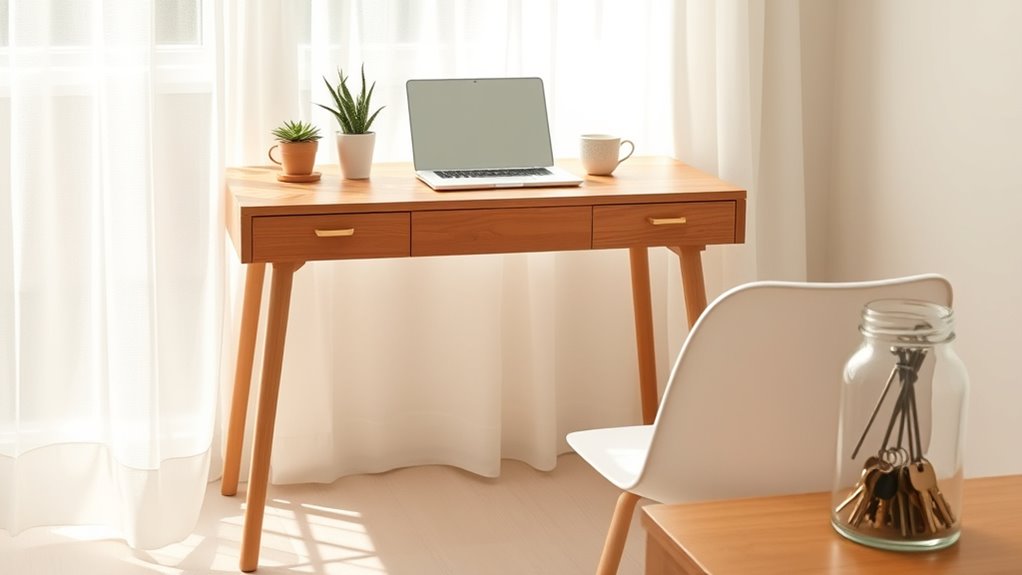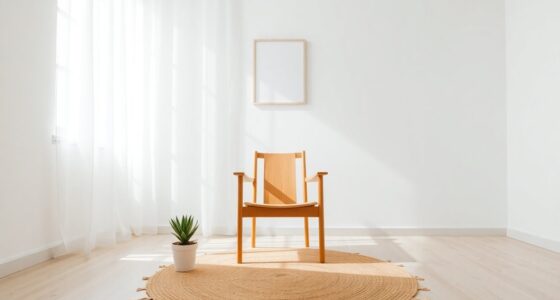To shift gradually into a minimalist lifestyle, start by evaluating your current habits and clarifying your priorities. Set realistic goals like decluttering one area each month and implementing small routines such as daily tidying. Practice mindful shopping by focusing on quality over quantity and reducing impulsive buys. Establish systems to maintain your space and embrace digital minimalism to cut digital clutter. Continuing this approach will help you create a simpler, more intentional life step by step.
Key Takeaways
- Start by assessing your current habits, goals, and daily routines to identify areas for gradual change.
- Tackle decluttering one space or category at a time to avoid overwhelm and see tangible progress.
- Implement small routines like daily tidying and weekly decluttering to maintain a minimalist environment gradually.
- Practice mindful consumption by pausing before purchases and prioritizing quality over quantity.
- Use digital tools and automation to streamline organization and sustain your minimalist lifestyle over time.
Assess Your Current Lifestyle and Priorities

Before you begin downsizing, it’s important to understand your current lifestyle and what truly matters to you. Start by evaluating your daily routines and habits, focusing on areas like budget planning and social commitments. Are you spending money on things you don’t need? Do your social activities align with your values and priorities? Identifying what brings you joy versus what drains resources helps clarify your goals. Take note of recurring expenses and commitments that may not serve your minimalist journey. Being honest about your current lifestyle sets a solid foundation for making intentional choices, ensuring your progression aligns with what you truly value. Additionally, cultivating creative practice can help you explore new ways to simplify and find fulfillment beyond material possessions, fostering a mindset of mindful consumption that supports your goals. Recognizing how automation and technological tools can assist in managing daily tasks efficiently may also ease your transition and reduce unnecessary clutter.
Set Realistic Goals for Your Minimalist Journey
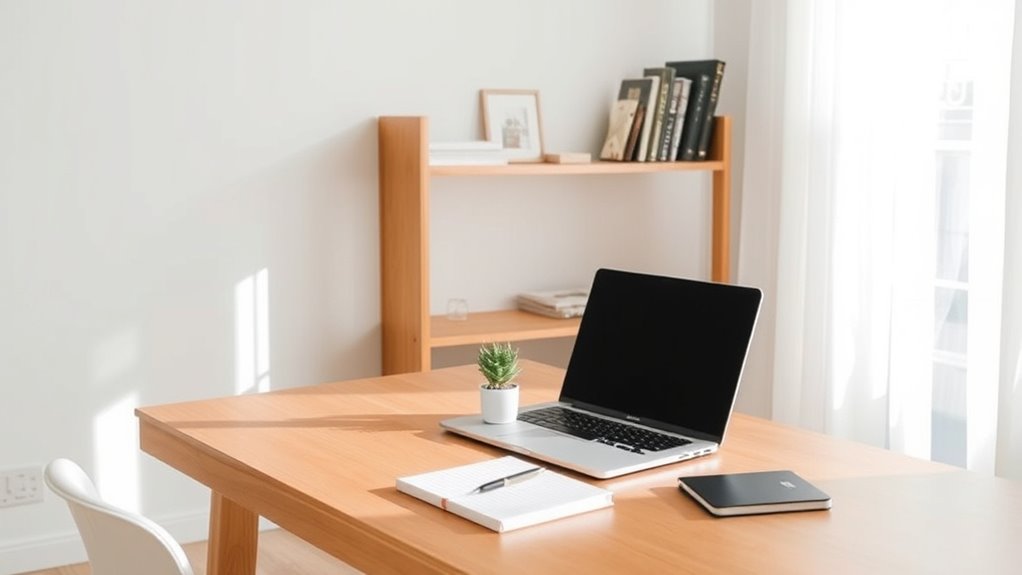
Setting realistic goals is essential to making steady progress on your minimalist journey. Start by setting achievable milestones that reflect your current lifestyle and priorities. Break down your larger goal into smaller, manageable steps, like decluttering one room or reducing your possessions by a certain amount each month. Tracking progress helps you stay motivated and aware of how far you’ve come. Celebrate small wins to build momentum and confidence. Remember, the goal isn’t perfection but consistency. Incorporating gradual changes, such as optimizing your space with the right home theatre projector, can make the transition feel more natural and sustainable over time. Understanding the impact of sound vibrations can also enhance your environment, making your minimalist space more relaxing and conducive to mindfulness. Additionally, choosing appropriate zoning laws for your tiny house can facilitate a smoother transition to a minimalist lifestyle in your new space. Practicing mindful decluttering strategies can further support responsible consumption and environmental sustainability, aligning with your minimalist goals.
Start With Decluttering One Area at a Time
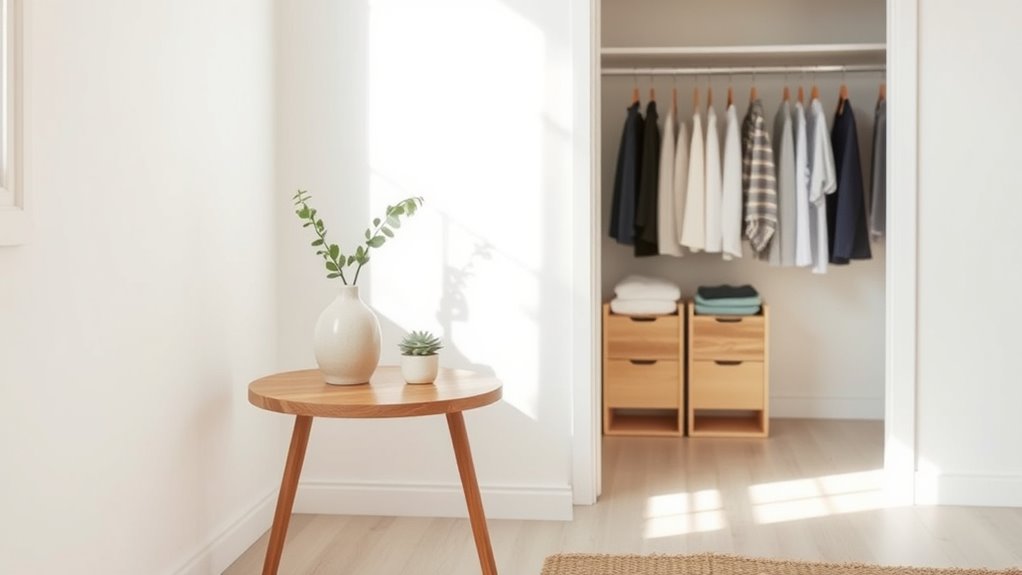
Begin by choosing one area to declutter, like your closet or kitchen. Set clear goals for what you want to remove and organize. Tackling one space at a time makes the process manageable and keeps you motivated. Focusing on a specific room type can help you create a more peaceful and organized environment. Incorporating innovative planters into your space during decluttering can inspire a fresh start and motivate ongoing organization efforts. Considering electric bike conversion kits for eco-friendly transportation options can also support your minimalist lifestyle by reducing clutter and promoting sustainable living. Additionally, engaging in urban biodiversity initiatives like creating wildlife habitats can further enhance your environment and well-being.
Focus on a Single Space
Why should you tackle decluttering one space at a time? Focusing on a single area makes the process manageable and prevents overwhelm. It allows you to see tangible progress, boosting motivation. Start with spaces like a closet or desk, where storage solutions can make a big difference. You’ll also find opportunities to reduce digital clutter—emails, files, photos—to streamline your environment. To stay organized, consider this approach:
| Space | Action | Outcome |
|---|---|---|
| Closet | Sort clothes, donate, organize with storage solutions | Clear, functional wardrobe |
| Desk | Declutter papers, digital files, set boundaries | Increased productivity |
| Living Area | Remove excess decor, streamline furniture | Calm, minimalist space |
Focusing on one space at a time creates sustainable change. Incorporating minimalist principles can further enhance your decluttering efforts by emphasizing quality over quantity and intentional living.
Set Decluttering Goals
Have you ever felt overwhelmed by the idea of decluttering your entire home all at once? That’s common, but adopting a minimalist mindset starts with setting clear decluttering goals.
Begin by choosing one area—like a closet or a drawer—and focus solely on it. Use decluttering techniques such as sorting items into keep, donate, or discard piles. To stay motivated, consider establishing a decluttering schedule that breaks the process into manageable sessions.
Setting small, achievable goals makes the process manageable and helps you stay motivated. Remember, the key is progress, not perfection.
As you successfully declutter each space, you’ll build confidence and momentum for tackling other areas. By taking it one step at a time, you’ll gradually create a clutter-free environment that aligns with your minimalist lifestyle, making the journey less formidable and more rewarding.
Additionally, incorporating small, affordable items like electric bikes can help you reduce car dependency and promote a more sustainable lifestyle. This approach not only simplifies your space but also encourages eco-friendly choices that support your minimalist goals. Embracing digital minimalism can further enhance your decluttering efforts by reducing digital clutter and streamlining your online life.
Implement Small Changes in Daily Routines

Small changes in your daily routines can make a significant difference when shifting to a minimalist lifestyle. Start by practicing mindful eating—pay attention to your hunger cues and savor each bite, reducing unnecessary snacking and waste. Incorporate regular digital detox periods, such as turning off devices an hour before bed or during meals, to minimize distractions and foster presence. Simplify your mornings by preparing a simple, clutter-free routine, like organizing essentials the night before. These small adjustments help you become more intentional with your time and choices, gradually reducing clutter and mental noise. Additionally, exploring sustainable building materials and innovative modular designs can inspire your journey toward a minimalist home environment. As you integrate mindful eating and digital detox into your daily life, you’ll find it easier to embrace minimalism and foster a more focused, peaceful mindset. Embracing curiosity about new sustainable practices can further motivate your transition and inspire creative solutions. Cultivating awareness of cultural traditions can also help you develop a personalized approach that respects your heritage while streamlining your lifestyle.
Practice Mindful Consumption and Shopping Habits

You should start recognizing impulsive purchases before they happen, as they can quickly clutter your space.
Focus on prioritizing essential items that genuinely add value to your life.
Practicing mindful shopping helps you make intentional choices and maintain your minimalist goals.
Recognize Impulsive Purchases
Recognizing impulsive purchases is a crucial step toward adopting a minimalist lifestyle, as it helps you become more aware of your spending triggers. When you practice impulse control, you start identifying the moments when urges to buy strike unexpectedly.
Developing spending awareness allows you to pause before making unplanned purchases, giving you time to evaluate if the item truly adds value to your life. Pay attention to your emotional state or environmental cues that often lead to spontaneous shopping.
By becoming mindful of these triggers, you gain better control over your spending habits. This awareness helps you resist unnecessary purchases and stay aligned with your goal of simplifying your possessions.
Over time, recognizing impulsive buys becomes second nature, making mindful consumption easier and more effective.
Prioritize Essential Items
After becoming more aware of your impulsive spending, the next step is to focus on purchasing only what truly matters. Use decluttering methods like the “one-in, one-out” rule to evaluate whether new items are necessary.
Implement budgeting strategies that allocate funds specifically for essentials, helping you resist unnecessary purchases. Before buying, pause and ask yourself if the item aligns with your priorities and if it adds real value to your life.
Practicing mindful consumption means being deliberate about what you bring into your space, reducing clutter and emotional attachment. Over time, this approach helps you develop habits that emphasize quality over quantity, ensuring your belongings serve a purpose and contribute to your minimalist lifestyle.
Simplify Your Wardrobe and Personal Items
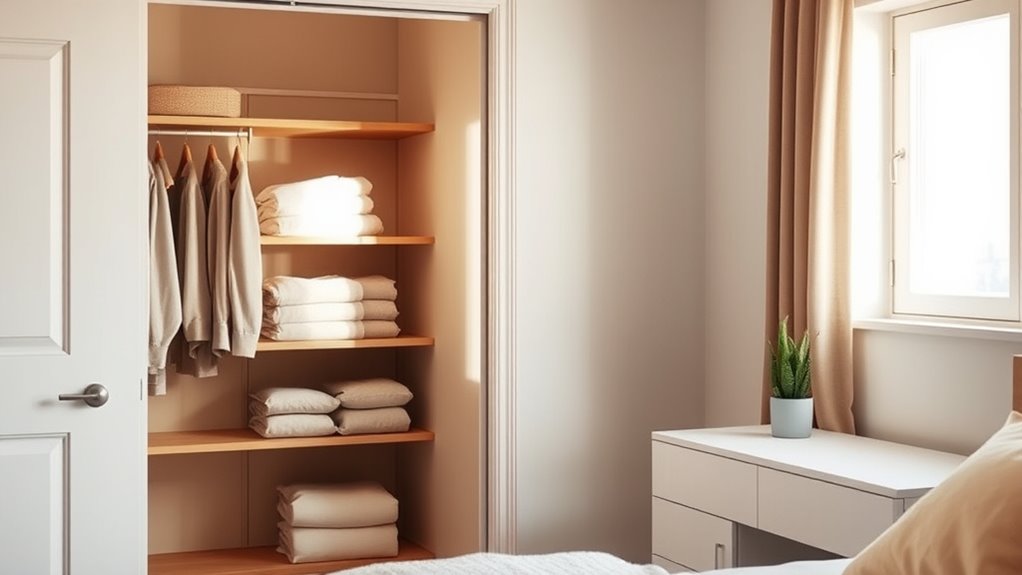
Simplifying your wardrobe and personal items begins with evaluating what you truly need and use regularly. Start by sorting through your clothing and accessories, setting aside items that no longer serve a purpose or bring you joy.
Participate in clothing swaps with friends or community groups to exchange pieces you no longer want, making space for what matters. Focus on accessory curation—keep only versatile, meaningful pieces that complement multiple outfits.
Be honest about your style and daily needs, resisting the urge to keep extras just in case. Regularly declutter to prevent accumulation, and develop a habit of assessing your belongings every few months.
This process helps you build a streamlined wardrobe that reflects your current life and simplifies your daily routine.
Create a System for Maintaining Your Space
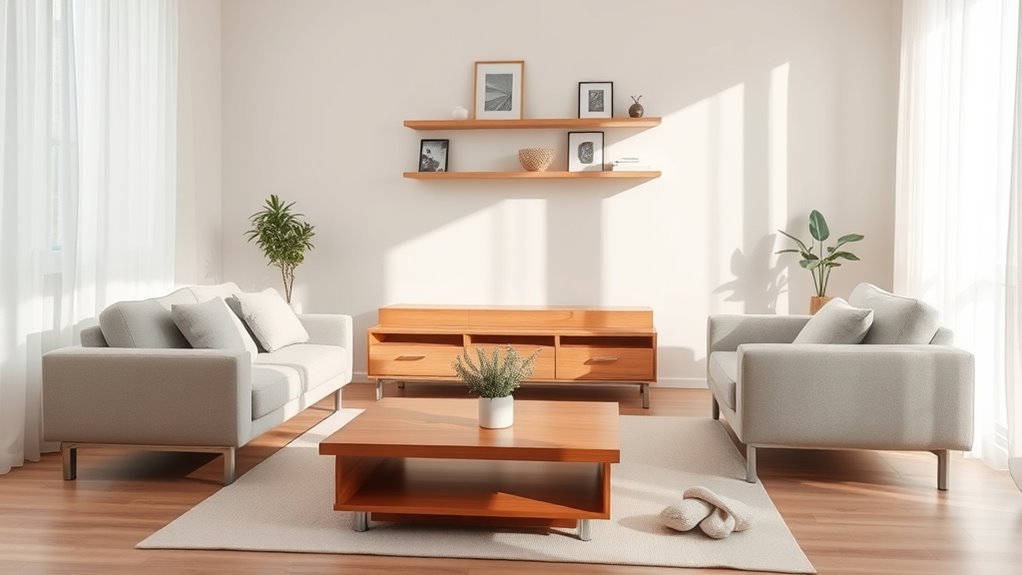
To keep your space minimalist, you’ll want to set up a system that works for you. This means organizing regularly, choosing simple storage options, and creating routines to stay on top of maintenance.
With these steps, maintaining your clutter-free environment becomes effortless.
Organize Regularly
Have you ever noticed how easily clutter sneaks back into your space when you don’t have a system in place? Regular organization keeps your minimalist goals on track. Use effective storage solutions to contain items and prevent chaos from building up.
Establish routines, like tidying daily or weekly, to maintain order. Incorporate digital minimalism by decluttering your devices regularly—delete unused apps, organize files, and unsubscribe from unnecessary emails.
Creating a system that’s easy to follow means you won’t feel overwhelmed, and clutter won’t accumulate unnoticed. Consistency is key. When you prioritize regular organization, you reinforce your new habits and make it easier to sustain your minimalist lifestyle long-term.
Staying proactive reduces stress and keeps your space calm and functional.
Simplify Storage Solutions
Creating an efficient storage system is essential for maintaining a clutter-free space that aligns with your minimalist goals. Start by choosing versatile storage containers that can hold items neatly and maximize space. Clear containers make it easy to identify contents quickly, reducing the need to open multiple boxes.
Incorporate simple shelving solutions to keep frequently used items accessible and organized. Use wall-mounted shelves to free up floor space and create designated zones for different categories, like books or kitchen supplies.
Avoid overstuffing storage areas; instead, prioritize quality and functionality. Regularly assess your storage setup, removing items that no longer serve a purpose.
A streamlined, intentional storage system helps you stay organized and committed to your minimalist lifestyle.
Establish Maintenance Routines
Once you’ve organized your space, establishing regular maintenance routines is key to keeping it clutter-free. Set aside a few minutes daily or weekly to tidy up, review belongings, and practice mindful eating by avoiding unnecessary food waste. Incorporate eco-friendly practices, like recycling and composting, into your routine to support sustainability. To help stay on track, consider this simple system:
| Routine Aspect | Purpose |
|---|---|
| Weekly decluttering | Prevent accumulation of clutter |
| Regular donation checks | Let go of items no longer needed |
| Routine Aspect | Purpose |
| Daily tidying | Maintain order and calm |
| Mindful consumption | Reduce waste and overconsumption |
These routines keep your space minimal and reinforce your eco-conscious lifestyle.
Emphasize Quality Over Quantity in Purchases

When you choose to prioritize quality over quantity, your purchases become more meaningful and long-lasting. Instead of chasing after fleeting trends, focus on items that offer durability and craftsmanship, like well-made clothing or sturdy furniture.
This shift often means investing in luxury branding that emphasizes craftsmanship and timeless style. Social influences can tempt you to buy numerous cheaper items, but resisting that urge helps you build a streamlined wardrobe and clutter-free space.
By selecting fewer, higher-quality pieces, you reduce waste and simplify decision-making. Over time, you’ll find your belongings hold greater value, both practically and sentimentally.
This approach encourages mindful consumption and supports a minimalist lifestyle rooted in intentionality rather than impulse.
Embrace Digital Minimalism to Reduce Clutter
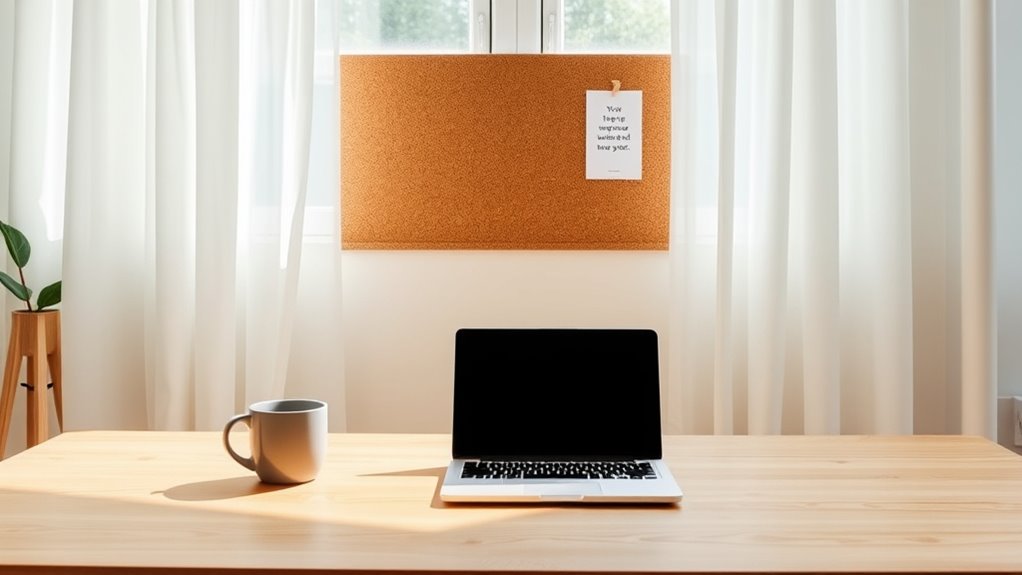
Digital clutter can quickly overwhelm your space and mind, making it harder to focus on what truly matters. To embrace digital minimalism, start with a digital detox—set aside time to disconnect from devices and reduce notifications. Next, streamline your online organization by deleting unused apps, unsubscribing from unnecessary emails, and organizing files into folders. This minimizes distractions and creates a calmer digital environment. Use tools like cloud storage or digital calendars to keep essential information accessible without clutter. Remember, reducing digital clutter isn’t a one-time task but a continuous effort toward simplicity. Here’s a quick overview:
| Action | Benefit |
|---|---|
| Digital detox | Clear mental space |
| Unsubscribe & delete | Reduce distractions |
| Organize files | Easy access, less chaos |
| Use digital tools | Maintain long-term minimalism |
Reflect on Your Progress and Adjust Your Approach
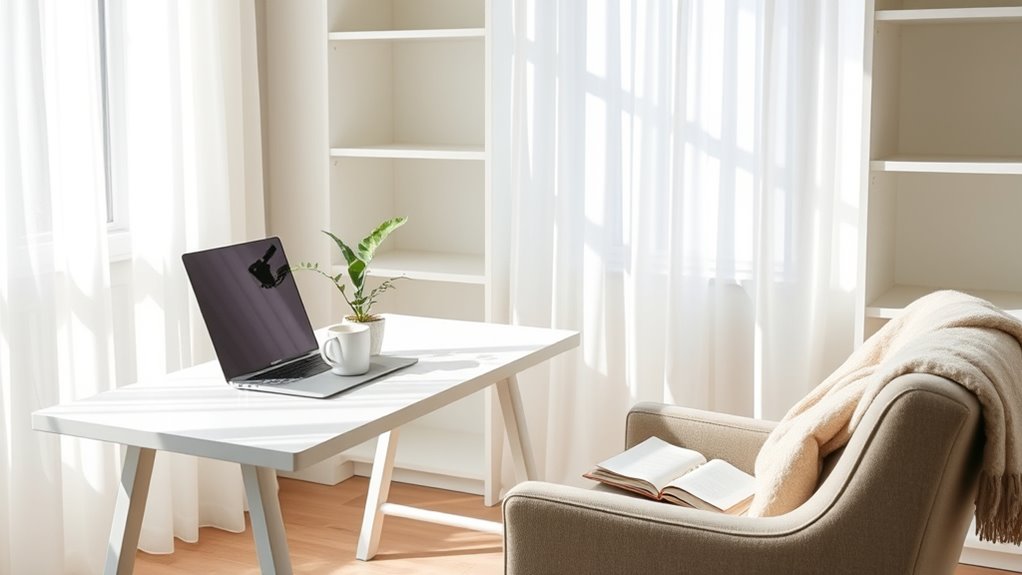
Regularly reflecting on your progress helps you identify what’s working and where adjustments are needed. Practice mindful reflection by honestly assessing how your minimalist efforts are impacting your daily life. Are you feeling more organized and less overwhelmed? If not, it’s time for goal adjustment.
Adjust your approach based on what you’ve learned, whether that means decluttering differently or setting new priorities. Keep track of your successes and setbacks to stay motivated and aware of your growth.
Frequently Asked Questions
How Long Does It Typically Take to See Results From Minimalism?
You might wonder about the timeframe expectations for seeing results from minimalism. Generally, you can notice visual progress within a few weeks, as clutter decreases and your space feels more open.
However, deeper benefits like mental clarity and reduced stress often take a few months to fully develop. Stay patient and consistent, and you’ll start experiencing the positive changes that minimalism brings, even if results vary based on individual effort.
Can I Still Keep Sentimental Items While Decluttering?
You can definitely keep sentimental items while decluttering, but setting clear decluttering boundaries helps. Decide which items truly hold emotional value and let go of duplicates or less meaningful keepsakes.
How Do I Handle Resistance From Family Members?
Think of family dynamics as a delicate dance; resistance often stems from emotional attachment and fears of change.
You can handle this by communicating openly and empathetically, showing respect for their feelings. Share your reasons for minimalism and involve them in small decisions.
Patience is key—you’re guiding, not forcing. Over time, understanding deepens, and resistance lessens, helping everyone find harmony in your new lifestyle.
What Are Common Pitfalls When Transitioning Gradually?
When shifting gradually, you might face common pitfalls like emotional attachment to belongings, making it hard to let go. Overcoming hesitation is key, but beware of rushing and feeling overwhelmed.
Take small steps at a pace that feels comfortable, and stay patient. Remember, the goal isn’t perfection but progress.
Is Minimalism Sustainable Long-Term Without Feeling Deprived?
You might wonder if minimalism is sustainable long-term without feeling deprived, especially when comparing it to luxury lifestyles filled with material possessions. The key is focusing on quality over quantity and finding joy in simplicity.
You can enjoy meaningful experiences without the excess, making minimalism fulfilling rather than restrictive. Over time, you’ll discover that living with less brings more clarity, freedom, and genuine happiness, proving it’s sustainable for the long haul.
Conclusion
As you gradually shed the excess, you’ll find your life blossoming like a well-tended garden. Remember, minimalism isn’t a destination but a journey of small, intentional steps. Stay patient and flexible, adjusting as you go. With each deliberate choice, you’re sculpting a space that reflects what truly matters—making your life clearer, calmer, and more meaningful. Keep nurturing this new lifestyle, and watch your world become a peaceful haven, one mindful step at a time.
